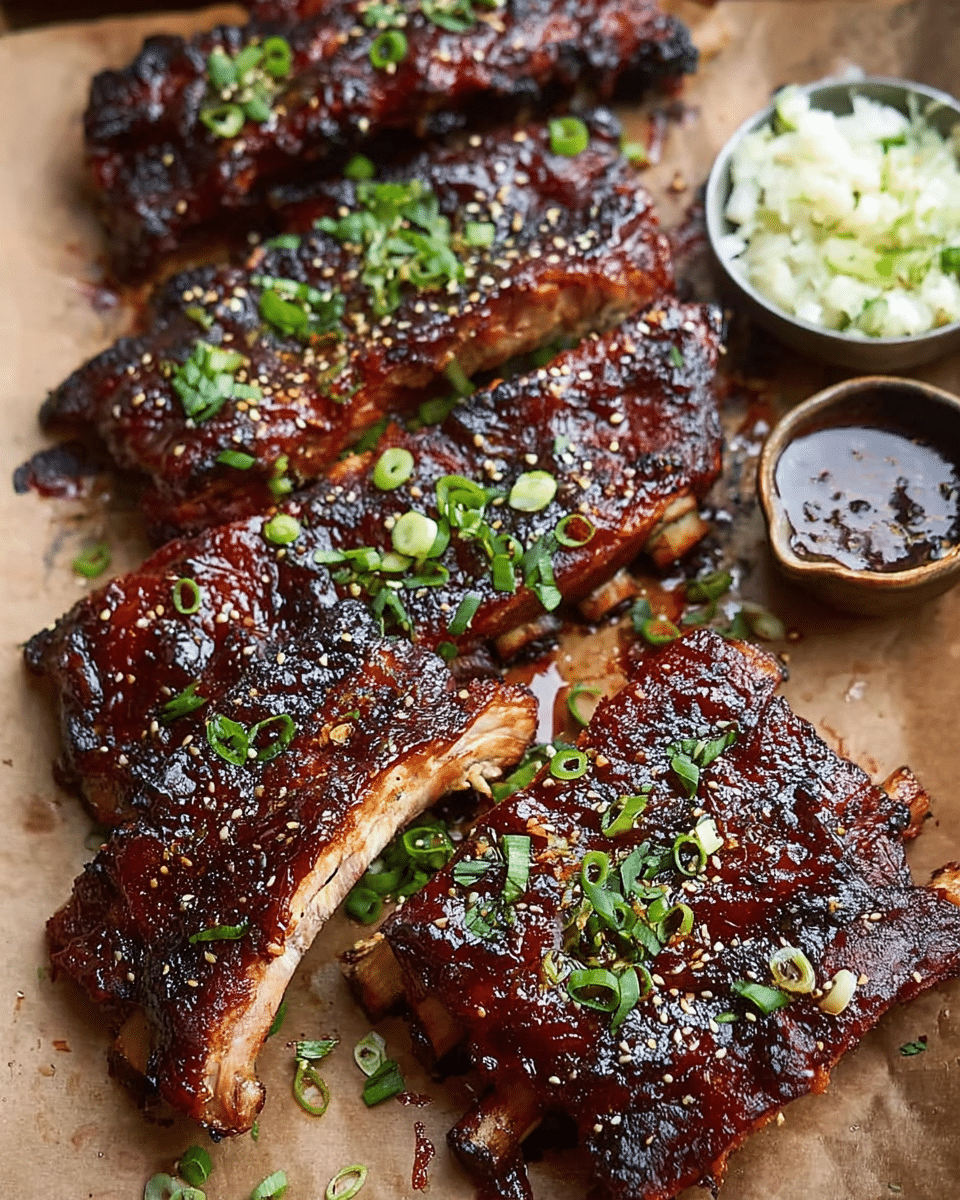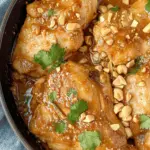These Sticky Asian Pork Ribs are baked low and slow until they’re fall-off-the-bone tender, then brushed with a sweet, garlicky, and slightly spicy glaze. With layers of flavor from smoked paprika, Chinese five spice, honey, and soy sauce, the ribs are both sticky and savory, perfect for summer gatherings or cozy indoor dinners. A quick broil at the end caramelizes the glaze for a beautiful, charred finish.
Full Recipe:
Ingredients
-
Ribs:
-
2.5 lbs St. Louis or baby back ribs (about 1 rack)
-
-
Dry Rub:
-
2 tbsp brown sugar
-
2 tsp smoked paprika
-
2 tsp Morton kosher salt
-
1 tsp granulated garlic
-
1 tsp granulated onion
-
¼ tsp ground ginger
-
¼ tsp Chinese five spice
-
¼ tsp white pepper
-
-
Glaze:
-
1 tbsp sesame oil
-
10–12 cloves garlic, minced
-
1 tbsp grated fresh ginger
-
⅔ cup brown sugar
-
½ cup soy sauce
-
⅓ cup rice vinegar
-
¼ cup honey
-
1 tsp red pepper flakes
-
Directions
-
Prep Ribs
-
Preheat oven to 275°F (135°C). Remove silver skin from back of ribs, cut into 3–4 portions, and pat dry.
-
-
Season
-
Mix dry rub ingredients and coat ribs on all sides. Wrap each portion tightly in foil and place on a baking sheet.
-
Bake: 2–2.5 hrs for baby back ribs, 2.5–3 hrs for St. Louis style.
-
-
Make Glaze
-
Heat sesame oil in a saucepan over medium-low. Sauté garlic and ginger 2 min.
-
Add brown sugar, soy sauce, rice vinegar, honey, and red pepper flakes. Bring to boil, reduce 5–7 min until thickened.
-
-
Glaze & Broil
-
Unwrap ribs, brush generously with glaze, and broil on high for 2–3 min until caramelized.
-
-
Serve
-
Slice into individual ribs and serve with extra glaze.
-
Nutrients (per serving, 4 servings)
-
Calories: ~620 kcal
-
Protein: ~32 g
-
Fat: ~32 g
-
Carbohydrates: ~50 g
-
Sugar: ~42 g
-
Sodium: ~1300 mg
Why Low and Slow Wins Every Time
The secret to perfectly tender ribs is patience. Cooking them at a low temperature for several hours allows the connective tissue to break down gradually, leaving you with juicy, fall-off-the-bone results. Unlike high-heat grilling that can sometimes leave ribs chewy or dry, slow roasting keeps the meat moist and full of flavor. The wrapped cooking method locks in steam, essentially braising the ribs in their own juices until they’re impossibly tender.
The Flavor Layers: Sweet, Savory, Spicy
These ribs aren’t just about texture—they’re a symphony of flavors. The dry rub lays the foundation with smoky paprika, aromatic Chinese five spice, and a hint of brown sugar for balance. As the ribs bake, these spices permeate the meat, giving every bite depth. Then comes the glaze, a luscious mix of soy sauce, honey, garlic, and ginger, with a kiss of red pepper flakes for heat. It’s sticky enough to cling to the ribs, yet balanced so no single flavor overpowers the others.
The Role of Chinese Five Spice
A key player in this recipe is Chinese five spice—a blend typically made of star anise, cloves, Chinese cinnamon, Sichuan peppercorns, and fennel seeds. This aromatic mix adds a subtle complexity, combining sweetness, warmth, and anise-like brightness. It transforms the ribs from simply sweet and smoky to something with a more exotic, multidimensional flavor profile, making them memorable long after the last bite.
Garlic and Ginger: The Flavor Backbone
Garlic and ginger are the backbone of the glaze. Their pungent, slightly spicy notes add both depth and freshness to balance the glaze’s sweetness. Gently sautéing them in sesame oil before adding the rest of the glaze ingredients allows their flavors to bloom, infusing the sauce from the start. These two ingredients, while humble, are what give the glaze its distinctive aroma and vibrant taste.
A Glaze That Does Double Duty
The glaze in this recipe isn’t just a final brush of flavor—it’s also a dipping sauce. After caramelizing on the ribs under the broiler, it retains enough body to serve alongside for extra coating or for drizzling over side dishes. The soy sauce delivers salty umami, the brown sugar and honey bring a deep sweetness, the vinegar adds tang, and the pepper flakes keep your palate engaged. It’s the kind of sauce you’ll want to bottle and keep on hand for other recipes.
The Broiling Magic
While the slow roast gives you tenderness, the quick blast under the broiler is what takes these ribs over the top. That final high heat caramelizes the sugars in the glaze, creating a slightly charred, lacquered finish. The contrast between the crispy edges and the juicy interior makes every bite exciting. It’s a step that takes just a few minutes but makes all the difference in both flavor and presentation.
Perfect for Gatherings
One of the best things about Sticky Asian Pork Ribs is their crowd-pleasing nature. You can prepare them mostly in advance, letting them bake gently while you focus on other dishes or enjoy time with guests. When you’re ready to serve, a quick glaze and broil turns them into a showstopper. Because they’re cut into individual ribs before serving, they’re ideal for sharing—just be prepared for sticky fingers and happy faces.
Pairing Suggestions
These ribs shine alongside light, fresh sides that balance their richness. A crisp Asian slaw with cabbage, carrots, and a sesame-ginger dressing works beautifully. Steamed jasmine rice or coconut rice helps soak up the glaze, while grilled vegetables add a smoky contrast. For drinks, pair with a cold lager, a fruity Riesling, or even a citrusy mocktail to cut through the richness of the meat.
A Year-Round Favorite
Although they’re a natural fit for summer barbecues, these ribs are equally at home in cooler months. In winter, pair them with roasted root vegetables and warm rice noodles for a cozy, satisfying meal. In spring and summer, serve them with fresh herbs, lime wedges, and a side of chilled cucumber salad to keep things bright and refreshing.
Tips for the Best Results
To ensure maximum tenderness, always remove the silver skin from the back of the ribs before cooking. This thin membrane can prevent flavors from penetrating and can become tough when cooked. Also, be generous with the dry rub—it’s the first flavor layer and will season the meat all the way through. When making the glaze, watch it closely as it reduces; you want it thick enough to coat a spoon but not so thick that it turns grainy. Finally, keep an eye on the broiler—sugars caramelize quickly, and there’s a fine line between perfectly charred and burnt.
Customizing the Heat and Sweetness
One of the joys of this recipe is how easy it is to adapt. If you prefer a spicier kick, increase the red pepper flakes or add a touch of chili paste to the glaze. For a sweeter result, use a little more honey or swap some of the brown sugar for dark molasses to deepen the flavor. You can also add fresh herbs like cilantro or Thai basil as a garnish for a pop of color and freshness.
Why These Ribs Stand Out
While there are countless rib recipes out there, these Sticky Asian Pork Ribs offer something unique: the perfect combination of a slow, gentle cooking method with a bold, exciting flavor profile. The blend of Eastern-inspired spices with classic barbecue techniques bridges culinary worlds, creating a dish that feels both familiar and exotic. It’s this balance of comfort and novelty that keeps people coming back for more.
Presentation Matters
When serving, arrange the ribs on a platter with a sprinkle of toasted sesame seeds and fresh herbs for a restaurant-worthy look. Add lime wedges on the side to give guests the option of squeezing fresh citrus over their ribs—it’s a simple touch that adds brightness and cuts through the richness. If serving at a party, provide plenty of napkins and maybe even some wet wipes—sticky ribs are meant to be enjoyed without worrying about a little mess.
Conclusion
Sticky Asian Pork Ribs are more than just a meal—they’re an experience. From the anticipation as they bake slowly in the oven to the irresistible aroma of the glaze simmering on the stove, this dish engages all your senses. The first bite, with its combination of tender meat, bold seasoning, and caramelized glaze, is pure satisfaction. Whether you’re cooking for family, friends, or just yourself, these ribs are a reminder that the best meals often come from taking the time to do things right. Once you’ve made them, they’re bound to become a staple in your recipe collection—one you’ll return to whenever you want to create a little magic at the dinner table.






